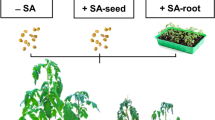Abstract
Under the conditions of a growing experiment, the authors studied the effect of presowing treatment of seeds with salicylic acid (SA) on the growth parameters and photosynthetic apparatus (PSA) of barley plants (Hordeum vulgare L.), which are in optimal conditions of mineral nutrition or with a lack of zinc in the root environment. It has been shown that zinc deficiency does not adversely affect PSA but causes inhibition of plant growth. Presowing treatment of seeds with SA (10 μM) had a stimulating effect on the intensity of photosynthesis and stomatal conductance, which ensured successful plant growth under conditions of zinc deficiency. At the same time, in plants grown from seeds treated with SA, the content of zinc in the roots and shoots was higher than in plants whose seeds were not treated. Based on the obtained results, a conclusion was made on the possibility and prospects of using presowing seed treatment with SA for growing barley plants under conditions of zinc deficiency in the root environment.



Similar content being viewed by others
REFERENCES
Cakmak, I., Torun, B., Erenoğlu, B., Öztürk, L.,Marschner, H., Kalayci, M., Ekiz, H., and Yilmaz, A., Morphological and physiological differences in the response of cereals to zinc deficiency, Euphytica, 1998, vol. 100, p. 349.
Sychev, V.G., Aristarkhov, A.N., Kharitonova, A.F., Tolstousov, V.P., Efimova, N.K., and Bushuev, N.N., Intensifikatsiya produktsionnogo protsessa rasteniy mikroelementami. Priemy upravleniya (Intensification of the Production Process of Plants Trace Elements. Management Techniques), Moscow: Vseross. Nauchno-issled. Inst. Agrokhim. im. D.N. Pryanishnikova 2009.
Alloway, B.J., Zinc in Soil and Crop Nutrition. Brussels: International Zinc Association, 2008, 2nd ed.
Kaznina, N.M. and Titov, A.F., Effect of zinc deficiency on physiological processes and cereal productivity, Usp. Sovrem. Biol., 2019, vol. 139, p. 280. https://doi.org/10.1134/S0042132419030037
Ali, A., Bhat, B.A., Rather, G.A., Malla, B.A., and Ganie, S., Proteomic studies of micronutrient deficiency and toxicity, in Plant Micronutrients. Deficiency and Toxicity Management, Aftab, T., and Hakeem, K.R., Eds., Springer, 2022, p. 257.
Khan, S.T., Malik, A., Alwarthan, A., and Shaik, M.R., The enormity of the zinc deficiency problem and available solutions; an overview, Arabian J. Chem., 2022, vol. 15. https://doi.org/10.1016/j.arabjc.2021.103668
Ryabchinskaya, T.A. and Zimina, T.V., Means regulating plant growth and development in agrotechnologies of modern plant growing, Agrokhimiya, 2017, vol. 12, p. 62.
Vlot, A.C., Dempsey, D.A., and Klessig, D.F., Salicylic acid, a multifaceted hormone to combat disease, Annu. Rev. Phytopathol., 2009, vol. 47, p. 177. https://doi.org/10.1146/annurev.phyto.050908.135202
Hayat, Q., Hayat, S., Irfan, M., and Ahmad, A., Effect of exogenous salicylic acid under changing environment: a review, Environ. Exp. Bot., 2010, vol. 68, p. 14. https://doi.org/10.1016/j.envexpbot.2009.08.005
Janda, T., Gondor, O.K., Yordanova, R., Szalai, G., and Pal, M., Salicylic acid and photosynthesis: signalling and effects, Acta Physiol. Plant., 2014, vol. 36, p. 2537. https://doi.org/10.1007/s11738-014-1620-y
Shakirova, F.M., Nespetsificheskaya ustoychivost’ rasteniy k stressovym faktoram i ee regulyatsiya (Nonspecific Resistance of Plants to Stress Factors and Its Regulation), Ufa: Gilem, 2001.
Horvath, E., Szalai, G., and Janda, T., Induction of abiotic stress tolerance by salicylic acid signaling, J. Plant Growth Regul., 2007, vol. 26, p. 290. https://doi.org/10.1007/s00344-007-9017-4
Khan, M.I.R., Fatma, M., Per, T.S., Anjum, N.A., and Khan, N.A., Salicylic acid-induced abiotic stress tolerance and underlying mechanisms in plants, Front. Plant Sci., 2015, vol. 6. https://doi.org/10.3389/fpls.2015.00462
Kolupaev, Yu.E., Yastreb, T.O., Polyakov, A.K., and Dmitriev, A.P., Salicylic acid and the formation of adaptive plant responses to abiotic stressors: the role of signaling network components. Vestn. Tomsk. Gos. Univ. Biol., 2021, vol. 55, p. 135. https://doi.org/10.17223/19988591/55/8
Wu, Q., Jing, H.‑K., Feng, Z.‑H., Huang, J., Shen, R.‑F., and Zhu, X.‑F., Salicylic acid acts upstream of auxin and nitric oxide (NO) in cell wall phosphorus remobilization in phosphorus deficient rice, Rice, 2022, vol. 15. https://doi.org/10.1186/s12284-022-00588-y
Su, T., Yu, S., Yu, R., Zhang, F., Yu, Y., Zhang, D., Zhao, X., and Wang, W., Effects of endogenous salicylic acid during calcium deficiency-induced tipburn in chinese cabbage (Brassica rapa L. ssp. pekinensis), Plant Mol. Biol. Rep., 2016, vol. 34, p. 607. https://doi.org/10.1007/s11105-015-0949-8
Kong, J., Dong, Y., Xu, L., Liu, S., and Bai, X., Effects of foliar application of salicylic acid and nitric oxide in alleviating iron deficiency induced chlorosis of Arachis hypogaea L., Bot. Stud., 2014, vol. 55. https://doi.org/10.1186/1999-3110-55-9
Shen, C., Yang, Y., Liu, K., Zhang, L., Guo, H., Sun, T., and Wang, H., Involvement of endogenous salicylic acid in iron-deficiency responses in Arabidopsis, J. Exp. Bot., 2016, vol. 67, p. 4179. https://doi.org/10.1093/jxb/erw196
Gunes, A., Inal, A., Alpaslan, M., Cicek, N., Guneri, E., Eraslan, F., and Guzelordu, T., Effects of exogenously applied salicylic acid on the induction of multiple stress tolerance and mineral nutrition in maize (Zea mays L.), Arch. Agron. Soil Sci., 2005, vol. 51, p. 687. https://doi.org/10.1080/03650340500336075
Khan, N.A., Syeed, S., Masood, A., Nazar, R., and Iqbal, N., Application of salicylic acid increases contents of nutrients and antioxidative metabolism in mungbean and alleviates adverse effects of salinity stress, Inter. J. Plant Biol., 2010, vol. 1. https://doi.org/10.4081/pb.2010.e1
Wang, C., Zhang, S., Wang, P., Hou, J., Qian, J., Ao, Y., Lu, J., and Li, L., Salicylic acid involved in the regulation of nutrient elements uptake and oxidative stress in Vallisneria natans (Lour.) Hara under Pb stress, Chemosphere, 2011, vol. 84, p. 136. https://doi.org/10.1016/j.chemosphere.2011.02.026
GOST (State Standard) 12038-84: Interstate Standard. Seeds of Agricultural Crops. Germination Methods, 1986.
Anikiev, V.V. and Kutuzov, F.F., A new method for determining the leaf area of cereals, Russ. J. Plant Phys., 1961, vol. 8, p. 375.
Svetov, S.A., Stepanova, A.V., Chazhengina, S.Yu., Svetova, E.N., Rybnikova, Z.P., Mikhaylova, A.I., Paramonov, A.S., Utitsyna, V.L., Ekhova, M.V., and Kolodey, V.S., Precision (ICP-MS, LA-ICP-MS) analysis of the composition of rocks and minerals: Methodology and assessment of the accuracy of results on the example of Early Precambrian mafic complexes, Trudy KarNTs RAN. Ser. Geol. Dokemb., 2015, vol. 7, p. 54.
Titov, A.F. and Talanova, V.V., Ustoychivost’ rasteniy i fitogormony (Plant Resistance and Phytohormones), Petrozavodsk: Karel’skiy nauchnyy tsentr RAN, 2009.
Rhaman, M.S., Imran, S., Rauf, F., Khatun, M., Baskin, C.C., Murata, Y., and Hasanuzzaman, M., Seed priming with phytohormones: an effective approach for the mitigation of abiotic stress, Plants, 2021, vol. 10. https://doi.org/10.3390/plants10010037
Per, T.S., Fatma, M., Asgher, M., Javied, S., and Khan, N.A., Salicylic acid and nutrients interplay in abiotic stress tolerance, Salicylic Acid: A Multifaceted Hormone, Nazar, R., Iqbal, N., and Khan, N.A., Eds., Springer, 2017, p. 221.
Krantev, A., Yordanova, R., Janda, T., Szalai, G., and Popova, L., Treatment with salicylic acid decreases the effect of cadmium on photosynthesis in maize plants, J. Plant Physiol., 2008, vol. 165, p. 920. https://doi.org/10.1016/j.jplph.2006.11.014
Hossian, B., Hirata, N., Nagatomo, Y., Akashi, R., and Takaki, H., Internal zinc accumulation is correlated with increased growth in rice suspension culture, J. Plant Growth Reg., 1997, vol. 16, p. 239.
Chen, W., Yang, X., He, Z. Feng, Y., and Hu, F., Differential changes in photosynthetic capacity, 77 K chlorophyll fluorescence and chloroplast ultrastructure between Zn-efficient and Zn-inefficient rice genotypes (Oryza sativa) under low zinc stress, Physiol. Plantarum., 2008, vol. 132, p. 89. https://doi.org/10.1111/j.1399-3054.2007.00992.x
Yavas, I. and Unay, A., Effects of zinc and salicylic acid on wheat under drought stress, JAPS, 2016, vol. 26, p. 1012.
Pirasteh‑Anosheh, H., Ranjbar, G., Hasanuzzaman, M., Khanna, K., Bhardwa, R., and Ahmad, P., Salicylic acid‑mediated regulation of morpho‑physiological and yield attributes of wheat and barley plants in deferring salinity stress, J. Plant Growth Regul., 2022, vol. 41, p.1291. https://doi.org/10.1007/s00344-021-10358-7
Yotsova, E.K., Dobrikova, A.G., Stefanov, M.A., Kouzmanova, M., and Apostolova, E.L., Improvement of the rice photosynthetic apparatus defence under cadmium stress modulated by salicylic acid supply to roots, Theor. Exp. Plant Physiol., 2018, vol. 30, p. 57. https://doi.org/10.1007/s40626-018-0102-9
Xu, L., Zhao, H., Ruan, W., Deng, M., Wang, F., Peng, J., Luo, J., Chen, Z., and Yib, K., ABNORMAL INFLORESCENCE MERISTEM1 functions in salicylic acid biosynthesis to maintain proper reactive oxygen species levels for root meristem activity in rice, The Plant Cell, 2017, vol. 29, p. 560. https://doi.org/10.1105/tpc.16.00665
Wang, H., Liu, R.L., and Jin, J.Y., Effects of zinc and soil moisture on photosynthetic rate and chlorophyll fluorescence parameters of maize, Biol. Plantarum, 2009, vol. 53, p. 191. https://doi.org/10.1007/s10535-009-0033-z
Khan, W., Prithiviraj, B., and Smith, D.L., Photosynthetic responses of corn and soybean to foliar application of salicylates, J. Plant Physiol., 2003, vol. 160, p. 485. https://doi.org/10.1078/0176-1617-00865
Liu, C., Guo, J., Cui, Y., Lü, T., Zhang, X., and Shi, G., Effects of cadmium and salicylic acid on growth, spectral reflectance and photosynthesis of castor bean seedlings, Plant Soil, 2011, vol. 344, p. 131. https://doi.org/10.1007/s11104-011-0733-y
Husen, A., Iqbal, M., Sohrab, S. S., and Ansari, M. K. A., Salicylic acid alleviates salinity caused damage to foliar functions, plant growth and antioxidant system in Ethiopian mustard (Brassica carinata A. Br.), Agric. Food Secur., 2018, vol. 7, p. 44. https://doi.org/10.1186/s40066-018-0194-0
Sedaghata, M., Tahmasebi-Sarvestania, Z., Emamb, Y., Mokhtassi-Bidgolia, A., and Sorooshzadeha, A., Foliar-applied GR24 and salicylic acid enhanced wheat drought tolerance, Russ. J. Plant Physiol., 2020, vol. 67, p. 733. https://doi.org/10.1134/S1021443720040159
Yildirim, E., Turan, M., and Guvenc, I., Effect of foliar salicylic acid applications on growth, chlorophyll, and mineral content of cucumber grown under salt stress, J. Plant Nutr., 2008, vol. 31, p. 593. https://doi.org/10.1080/01904160801895118
Funding
The study was supported by a grant from the Russian Science Foundation (project no. 22-26-00168, https://rscf.ru/ projent/22-26-00168/). The equipment of the Center for Collective Use of the Federal Research Center Karelian Scientific Center, Russian Academy of Sciences, was used in the work.
Author information
Authors and Affiliations
Corresponding author
Ethics declarations
COMPLIANCE WITH ETHICAL STANDARDS
This article does not contain any studies involving humans and animals as research subjects.
CONFLICT OF INTEREST
The authors declare that they have no conflicts of interest.
Additional information
Abbreviations: SA, salicylic acid; PSA, photosynthetic apparatus.
Rights and permissions
About this article
Cite this article
Ignatenko, A.A., Batova, Y.V., Kholoptseva, E.S. et al. Influence of Presowing Treatment of Seeds with Salicylic Acid on Growth and Photosynthetic Apparatus of Barley with Different Zinc Contents in Substrate. Russ J Plant Physiol 70, 35 (2023). https://doi.org/10.1134/S1021443723700115
Received:
Revised:
Accepted:
Published:
DOI: https://doi.org/10.1134/S1021443723700115




